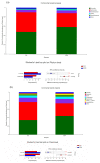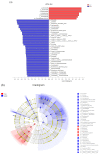Alterations in Intestinal Antioxidant and Immune Function and Cecal Microbiota of Laying Hens Fed on Coated Sodium Butyrate Supplemented Diets
- PMID: 35268114
- PMCID: PMC8908843
- DOI: 10.3390/ani12050545
Alterations in Intestinal Antioxidant and Immune Function and Cecal Microbiota of Laying Hens Fed on Coated Sodium Butyrate Supplemented Diets
Abstract
This study was designed to evaluate the effects of dietary coated sodium butyrate (CSB) on the intestinal antioxidant, immune function, and cecal microbiota of laying hens. A total of 720 52-week-old Huafeng laying hens were randomly allocated into five groups and fed a basal diet supplemented with CSB at levels of 0 (control), 250 (S250), 500 (S500), 750 (S750), and 1000 (S1000) mg/kg for eight weeks. The results revealed that CSB supplementation quadratically decreased the malondialdehyde content and increased the superoxide dismutase activity of the jejunum as well as the total antioxidative capacity activity of the ileum (p < 0.05). Dietary CSB supplementation linearly decreased the diamine oxidase and D-lactic acid content of the serum (p < 0.05). Compared with the control group, the addition of CSB resulted in linear and/or quadratic effects on the mRNA expression of inflammatory cytokines TNF-α, IL-6, and IL-10 in the jejunum and ileum (p < 0.05). The short-chain fatty acid concentrations increased quadratically as supplemental CSB improved (p < 0.05). Additionally, dietary CSB levels had no effect on microbial richness estimators, but ameliorated cecal microbiota by raising the abundance of probiotics and lowering pathogenic bacteria enrichment. In conclusion, our results suggest that dietary supplementation with CSB could improve the intestinal health of laying hens via positively influencing the antioxidant capacity, inflammatory cytokines, short-chain fatty acids, and gut microbiota. In this study, 500 mg/kg CSB is the optimal supplement concentration in the hens’ diet.
Keywords: cecal microbiota; coated sodium butyrate; immune function; laying hens.
Conflict of interest statement
The authors declare that there is no conflict of interest.
Figures









Similar articles
-
Dietary supplementation of coated sodium butyrate improves growth performance of laying ducks by regulating intestinal health and immunological performance.Front Immunol. 2023 Mar 9;14:1142915. doi: 10.3389/fimmu.2023.1142915. eCollection 2023. Front Immunol. 2023. PMID: 36969242 Free PMC article.
-
Effects of Long-Term Coated Sodium Butyrate Supplementation on the Intestinal Health and Colonization of Cecal Salmonella of Laying Hens Infected with Salmonella enteritidis.Animals (Basel). 2024 Apr 30;14(9):1356. doi: 10.3390/ani14091356. Animals (Basel). 2024. PMID: 38731359 Free PMC article.
-
Dietary Coated Sodium Butyrate Ameliorates Hepatic Lipid Accumulation and Inflammation via Enhancing Antioxidative Function in Post-Peaking Laying Hens.Metabolites. 2023 May 10;13(5):650. doi: 10.3390/metabo13050650. Metabolites. 2023. PMID: 37233691 Free PMC article.
-
Coated sodium butyrate ameliorates high-energy and low-protein diet induced hepatic dysfunction via modulating mitochondrial dynamics, autophagy and apoptosis in laying hens.J Anim Sci Biotechnol. 2024 Feb 2;15(1):15. doi: 10.1186/s40104-023-00980-8. J Anim Sci Biotechnol. 2024. PMID: 38302976 Free PMC article.
-
Peppermint extract improves egg production and quality, increases antioxidant capacity, and alters cecal microbiota in late-phase laying hens.Front Microbiol. 2023 Sep 21;14:1252785. doi: 10.3389/fmicb.2023.1252785. eCollection 2023. Front Microbiol. 2023. PMID: 37808324 Free PMC article.
Cited by
-
Gastric Infusion of Short-Chain Fatty Acids Improves Health via Enhance Liver and Intestinal Immune Response and Antioxidant Capacity in Goats.Vet Sci. 2025 Apr 22;12(5):395. doi: 10.3390/vetsci12050395. Vet Sci. 2025. PMID: 40431488 Free PMC article.
-
The New Buffer Salt-Protected Sodium Butyrate Promotes Growth Performance by Improving Intestinal Histomorphology, Barrier Function, Antioxidative Capacity, and Microbiota Community of Broilers.Biology (Basel). 2024 May 1;13(5):317. doi: 10.3390/biology13050317. Biology (Basel). 2024. PMID: 38785799 Free PMC article.
-
Dietary supplementation with Dendrobium officinale leaves improves growth, antioxidant status, immune function, and gut health in broilers.Front Microbiol. 2023 Sep 18;14:1255894. doi: 10.3389/fmicb.2023.1255894. eCollection 2023. Front Microbiol. 2023. PMID: 37789853 Free PMC article.
-
Dietary supplementation of coated sodium butyrate improves growth performance of laying ducks by regulating intestinal health and immunological performance.Front Immunol. 2023 Mar 9;14:1142915. doi: 10.3389/fimmu.2023.1142915. eCollection 2023. Front Immunol. 2023. PMID: 36969242 Free PMC article.
References
-
- Liu Y., Chen Z., Dai J., Yang P., Xu W., Ai Q., Zhang W., Zhang Y., Zhang Y., Mai K. Sodium butyrate supplementation in high-soybean meal diets for turbot (Scophthalmus maximus L.): Effects on inflammatory status, mucosal barriers and microbiota in the intestine. Fish Shellfish. Immunol. 2019;88:65–75. doi: 10.1016/j.fsi.2019.02.064. - DOI - PubMed
-
- Wu P., Tian L., Zhou X.Q., Jiang W.D., Liu Y., Jiang J., Xie F., Kuang S.Y., Tang L., Tang W.N., et al. Sodium butyrate enhanced physical barrier function referring to Nrf2, JNK and MLCK signaling pathways in the intestine of young grass carp (Ctenopharyngodon idella) Fish Shellfish Immunol. 2018;73:121–132. doi: 10.1016/j.fsi.2017.12.009. - DOI - PubMed
-
- Hoste H., Torres-Acosta J.F., Sandoval-Castro C.A., Mueller-Harvey I., Sotiraki S., Louvandini H., Thamsborg S.M., Terrill T.H. Tannin containing legumes as a model for nutraceuticals against digestive parasites in livestock. Vet. Parasitol. 2015;212:5–17. doi: 10.1016/j.vetpar.2015.06.026. - DOI - PubMed
Grants and funding
LinkOut - more resources
Full Text Sources

